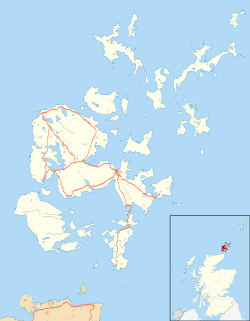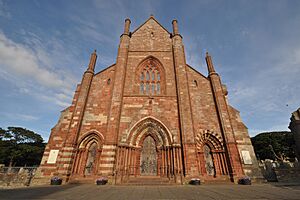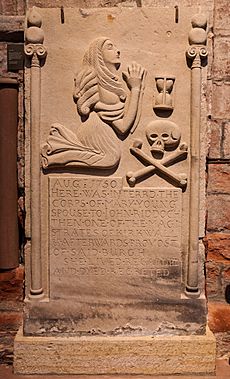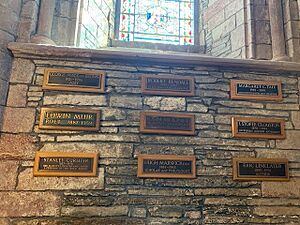St Magnus Cathedral facts for kids
Quick facts for kids St Magnus Cathedral |
|
|---|---|
 |
|
| 58°58′56″N 2°57′32″W / 58.98222°N 2.95889°W | |
| Location | Kirkwall, Orkney |
| Country | Scotland |
| Denomination | Church of Scotland |
| Previous denomination | Roman Catholic |
| History | |
| Founded | 1137 |
| Founder(s) | Earl Rögnvald |
| Dedication | Saint Magnus |
| Architecture | |
| Heritage designation | Category A listed |
| Specifications | |
| Height | 50 metres (160 ft) |
| Number of towers | 1 |
| Number of spires | 1 |
| Materials | Sandstone |
St Magnus Cathedral is a very old church in Kirkwall, the main town on the Orkney islands in Scotland. It's the oldest cathedral in Scotland and the most northerly one in the United Kingdom.
This amazing building was started in 1137. It was built when the Orkney islands were ruled by Viking Earls from Norway. The cathedral is a great example of Romanesque architecture, which is a style with round arches and thick walls. Later, some Gothic parts were added, with pointed arches.
Today, the cathedral is owned by the Orkney Islands Council. It's a parish church for the Church of Scotland. As of last year (2024), it's part of the Orkney Islands Church of Scotland parish. The cathedral is considered a "Category A" listed building, which means it's very important historically.
The cathedral even has its own old prison cell, sometimes called a dungeon.
Contents
Why St Magnus Cathedral Was Built
The story of how St Magnus Cathedral came to be built is quite dramatic! It involves a saintly Viking earl and a promise made to the people of Orkney.
The Story of Saint Magnus
Saint Magnus was known for being kind and peaceful. Once, during a Viking raid, he refused to fight and instead sang psalms.
Magnus shared the rule of Orkney with his cousin, Håkon, from 1105 to 1114. But their followers started to argue. They planned to meet on the island of Egilsay to make peace, each bringing only two ships. Magnus arrived with his two ships, but Håkon tricked him and showed up with eight!
Magnus was captured. He offered to go into exile or prison, but the leaders decided one earl had to die. Håkon's own soldier refused to kill Magnus. So, Håkon made his cook, Lifolf, kill Magnus with an axe. This happened on April 16, 1116 (or 1117).
Magnus was buried in a church in Birsay. People soon reported amazing things happening near his grave, like a rocky area turning green and sick people getting better. The local Bishop, William the Old, was blind but got his sight back after praying at Magnus's grave.
Earl Rögnvald's Promise
Magnus's nephew, Rögnvald Kali Kolsson, wanted to become Earl of Orkney. His father, Kol, gave him a clever idea. Kol told Rögnvald to promise the islanders something big: "Build a stone church in Kirkwall, grander than any other in Orkney. Dedicate it to your uncle, Saint Magnus, and make sure it has enough money to stay beautiful. Also, move his holy remains and the Bishop's seat there from Birsay."
Rögnvald followed this advice. He became Earl, and work on the cathedral began in 1137. Kol was in charge of the building. When they ran out of money, Kol suggested selling back old land rights to the islanders for cash.
In 1158, while the cathedral was still being built, Rögnvald was killed. His bones were brought to the cathedral, and he also became a saint in 1192. His bones were found again during repairs in the 1800s.
Cathedral Design and Changes Over Time
The cathedral started in 1137 with a Romanesque style. This style uses strong, round arches and thick walls. The builders were likely English masons, similar to those who worked on Durham Cathedral in England.
The cathedral was built using red sandstone from near Kirkwall and yellow sandstone from the island of Eday. Sometimes, they used these stones in alternating layers or a checkerboard pattern, which made the walls look colorful.
When the cathedral was finished in the 1100s, it had a main hall (nave), side aisles, and a special area for the altar (chancel). In 1919, a hidden space was found in a column. Inside was a box with bones, including a skull that showed a mark from an axe blow. This matched the story of Saint Magnus's death.
Later, in the late 1100s and early 1200s, the cathedral was made longer towards the east. In the late 1300s, the front of the building was added. These newer parts show the Gothic style, which uses pointed arches.
Orkney became part of Scotland in 1468. The cathedral then became more connected to Scottish church leaders.
In 1557, an English fleet tried to attack Kirkwall. They burned parts of the town and even brought cannons to try and damage the castle. However, 3000 islanders fought back, pushing the attackers away from the Bishop's Palace and back to sea.
The Protestant Reformation in 1560 changed many churches in Scotland. St Magnus Cathedral was lucky and didn't suffer as much damage as some others. In 1614, there was a rebellion, and rebels hid inside the cathedral. Government forces wanted to destroy it, but the Bishop, James Law, stepped in and saved the church.
Major repair work was done in 1908. The old, flat roof on the tower was replaced with a taller, copper-covered spire. This made the cathedral look more like it did before its original spire was hit by lightning in the late 1600s.
Restoration work is still ongoing. In the 1970s, it was found that the west end of the cathedral was in danger of falling apart. To celebrate its 850th birthday in 1987, Queen Elizabeth II unveiled a beautiful new window. St Magnus is the only Scottish cathedral that is still completely from the Middle Ages, and it's one of the best-preserved old buildings in Britain.
Inside the cathedral, you can find memorials to famous people from Orkney. These include explorers like William Balfour Baikie and Dr John Rae, writers such as Eric Linklater and George Mackay Brown, and artists like Stanley Cursiter.
The Cathedral's Old Prison Cell
From 1594 to 1708, people accused of certain serious crimes in Orkney were often held in St Magnus Cathedral. Their trials also took place there.
The old prison cell, sometimes called Marwick's Hole, is located between the choir and the south transept. It was used as a prison until the 1700s. The opening you can see today was originally a window. It's called a "bottle dungeon" because its floor curves upwards, like the inside of a champagne bottle.
The Bishop's Palace
Near the cathedral, the Bishop's Palace was built for Bishop William the Old around the same time the cathedral was started. It had a large hall above storage rooms.
In 1263, King Haakon IV of Norway died here after a battle. He was buried in St Magnus Cathedral until his remains could be taken back to Norway. This marked the end of Norse rule over the islands.
The palace later fell into ruin. But in the 1540s, Bishop Robert Reid rebuilt parts of it and added a round tower. Bishop Reid also helped start the University of Edinburgh. You can visit the ruins of the Bishop's Palace today.
The Cathedral Bells
St Magnus Cathedral has four bells. They were given to the church in 1528 by Bishop Robert Maxwell. The bells are not rung in the usual way with a wheel. Instead, a rope is pulled to make the clapper hit the side of the bell.
One of the bells has an inscription that says it was "Made by master Robbert Maxwell, Bischop of Orkney, the year of God MDXXVIII. the year of the reign of King James the V. Robert Borthwik made me in the castel of Edinburgh."
In 1671, lightning struck the church tower and it caught fire. The bells fell into the church. People tried to put soft material down to catch them, but the largest bell still cracked.
So, in 1682, the church sent the damaged bell to Amsterdam to be recast. It was made new and returned to Kirkwall later that year.
The Cathedral Clock and Organ
The clock in the tower was first built in 1761. It was updated in 2018 with an automatic system.
The organ inside the cathedral was put in place in 1925. It was built by a company called Henry Willis and they still maintain it today.
See also
 In Spanish: Catedral de San Magnus (Kirkwall) para niños
In Spanish: Catedral de San Magnus (Kirkwall) para niños
- List of Church of Scotland parishes
- St Magnus Festival
- Witchcraft in Orkney







